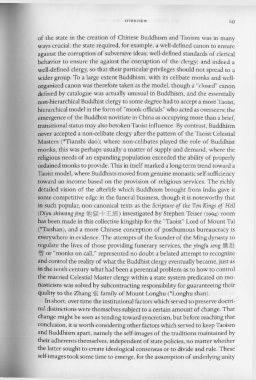Page 183 - The Encyclopedia of Taoism v1_A-L
P. 183
OVERVIEW 143
of the state in the creation of Chinese Buddhism and Taoism was in many
ways crucial: the state required, for example, a well-defined canon to ensure
against the corruption of subversive ideas; well-defined standards of clerical
behavior to ensure the against the corruption of the clergy; and indeed a
well-defined clergy, so that their particular privileges should not spread to a
wider group. To a large extent Buddhism, with its celibate monks and well-
organized canon was therefore taken as the model, though a "closed" canon
defined by catalogue was actually unusual in Buddhism, and the essentially
non-hierarchical Buddhist clergy to some degree had to accept a more Taoist,
hierarchical model in the form of "monk-officials" who acted as overseers; the
emergence of the Buddhist novitiate in China as occupying more than a brief,
transitional status may also betoken Taoist influence. By contrast, Buddhism
never accepted a non-celibate clergy after the pattern of the Taoist Celestial
Masters (*Tianshi dao); where non-celibates played the role of Buddhist
monks, this was perhaps usually a matter of supply and demand, where the
religiOUS needs of an expanding population exceeded the ability of properly
ordained monks to provide. This in itself marked a long-term trend toward a
Taoist model, where Buddhists moved from genuine monastic self-sufficiency
toward an income based on the provision of religious services. The richly
detailed vision of the afterlife which Buddhism brought from India gave it
some competitive edge in the funeral business, though it is noteworthy that
in such popular, non-canonical texts as the SCripture of the Ten Kings of Hell
(Diyu shiwangjing :Lmf~+ £~) investigated by Stephen Teiser (1994) room
has been made in this collective kingship for the "Taoist" Lord of Mount Tai
(*Taishan), and a more Chinese conception of posthumous bureaucracy is
everywhere in evidence. The attempts of the founder of the Ming dynasty to
regulate the lives of those providing funerary services, the yingfU seng J!}l1
f'lff or "monks on call," represented no doubt a belated attempt to recognize
and control the reality of what the Buddhist clergy eventually became, just as
in the tenth century what had been a perennial problem as to how to control
the married Celestial Master clergy within a state system predicated on mo-
nasticism was solved by subcontracting responsibility for guaranteeing their
quality to the Zhang '* family of Mount Longhu (*Longhu shan).
In short, over time the institutional factors which served to preserve doctri-
nal distinctions were themselves subject to a certain amount of change. That
change might be seen as tending toward syncretism, but before reaching that
conclusion, it is worth considering other factors which served to keep Taoism
and Buddhism apart, namely the self-images of the traditions maintained by
their adherents themselves, independent of state policies, no matter whether
the latter sought to create ideological consensus or to divide and rule. These
self-images took some time to emerge, for the assumption of underlying unity

